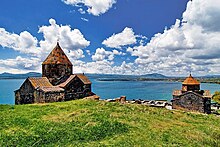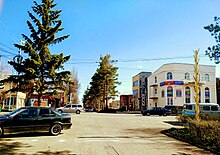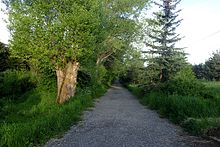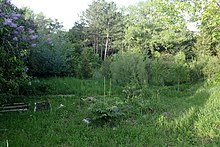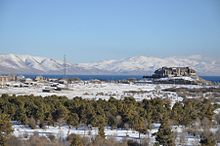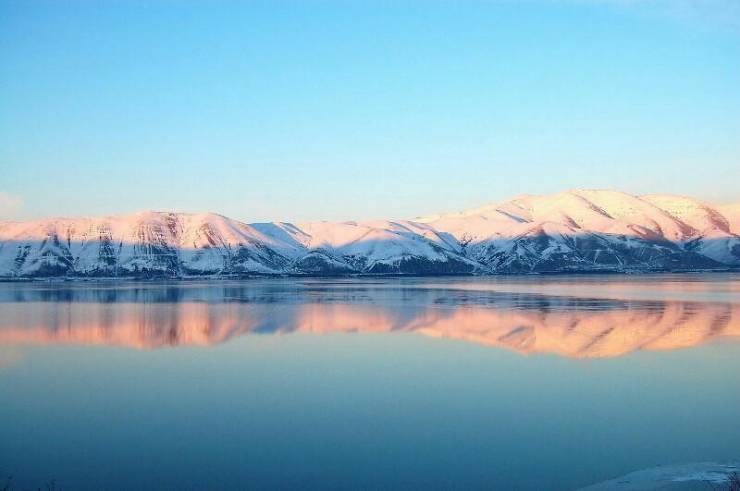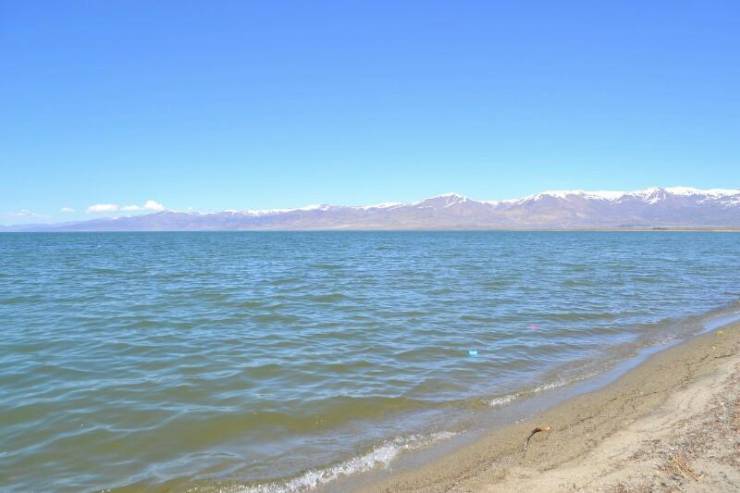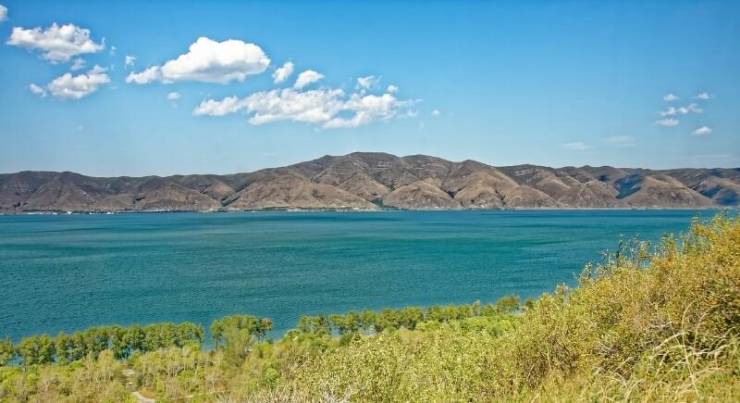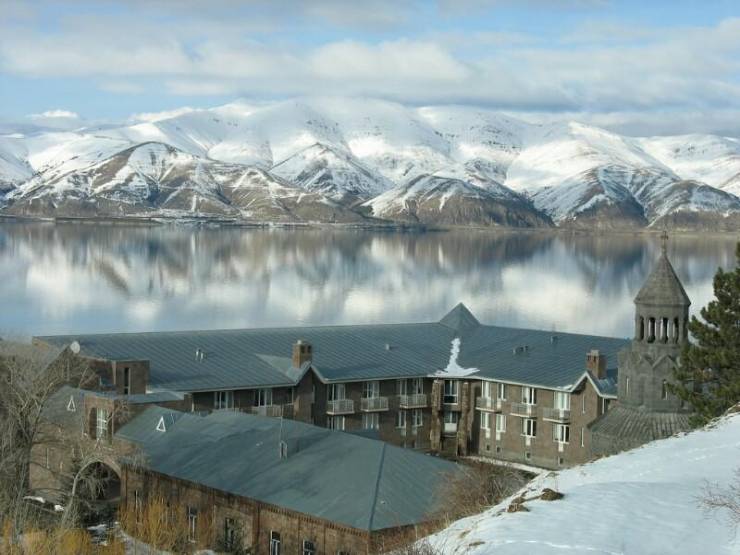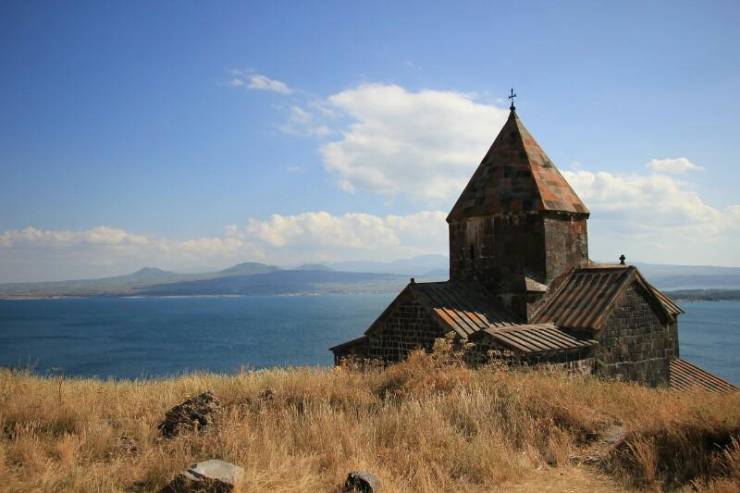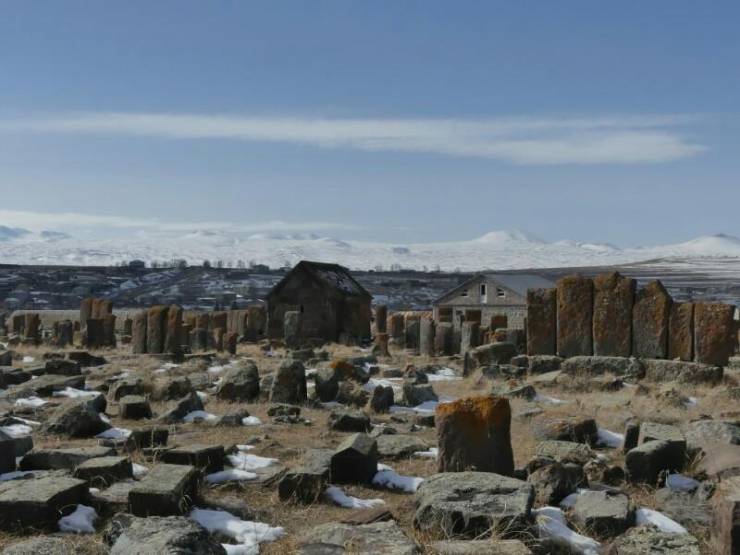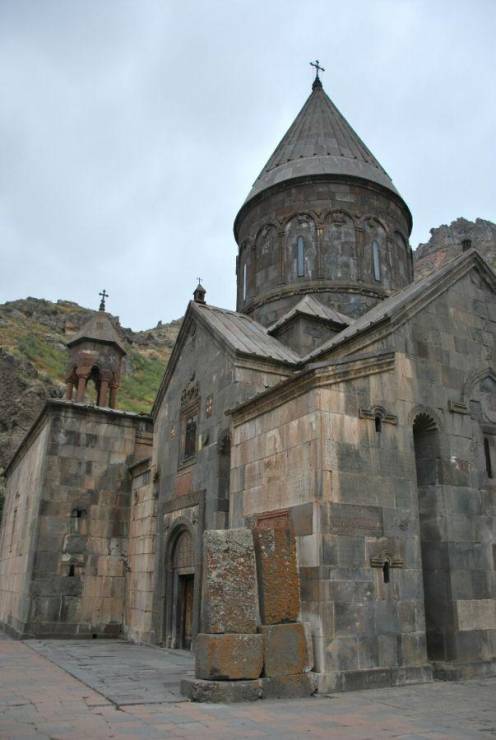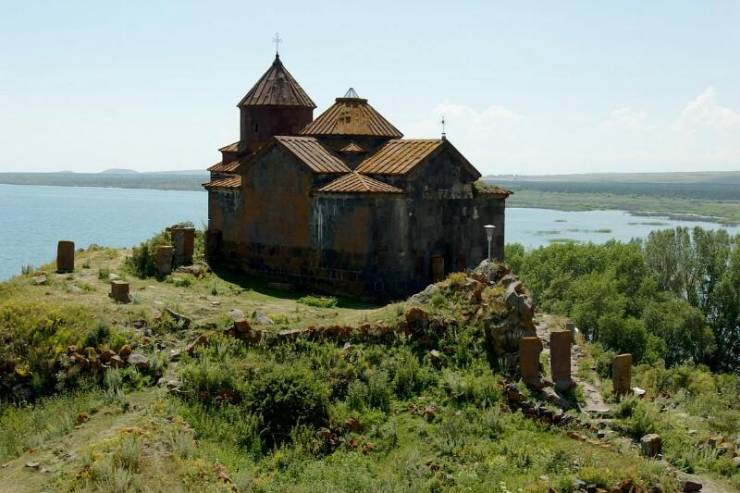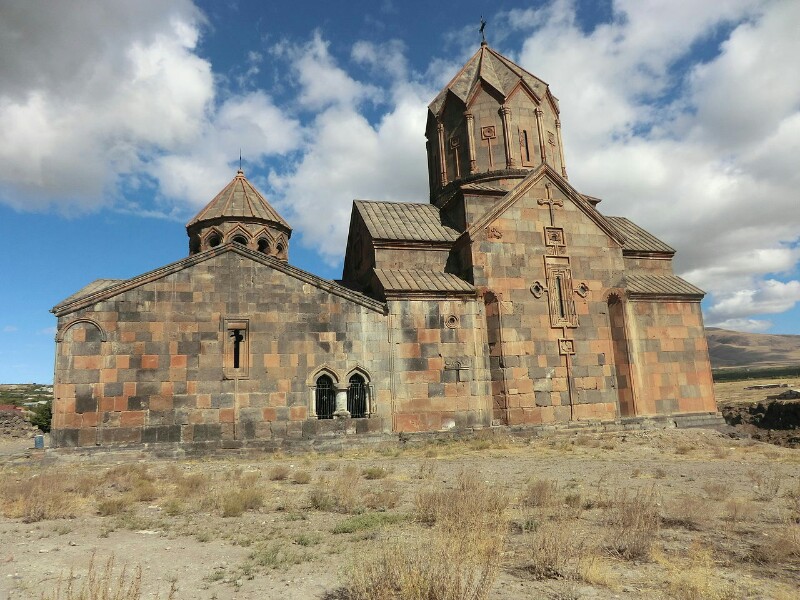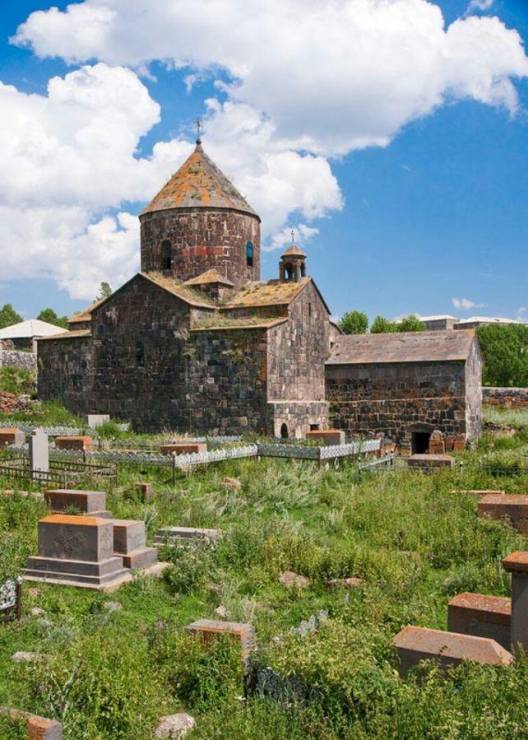севан
-
1
ԲԱԽՏԱԿ
ի (կենդբ.) Бахтак, форель в период нереста (о рыбе, водящейся в озере Севан).
Armenian-Russian dictionary > ԲԱԽՏԱԿ
-
2
ԼԻՃ
լճի Озеро. Սևանա լիճ озеро Севан.
* * *
[N]
озеро (N)
Armenian-Russian dictionary > ԼԻՃ
См. также в других словарях:
-
Севан — озеро, Армения. До недавнего времени гидроним Севан объясняли из совр. арм. сев черный и ванк монастырь , по цвету стен монастыря, построенного на этом озере из вулканического туфа, что оказалось народной этимологией. Расшифровка клинописи на… … Географическая энциклопедия
-
СЕВАН — (Гокча), самое большое озеро на Кавказе (на высоте 1900 м), в Армении. Площадь 1240 км2. Глубина до 83 м. Впадает 28 небольших рек; сток в реку Раздан, воды которой используются каскадом гидроэлектростанций. Для повышения уровня воды в озере… … Современная энциклопедия
-
Севан — I Гокча, озеро в Армении, на высоте 1900 м. 1240 км2. Глубина до 83 м. Вытекает р. Раздан. Воды Севана и Раздана используются Севанским каскадом ГЭС. Для пополнения вод Севана построен тоннель (49 км) для переброски в озеро вод р. Арпа. Туризм.… … Энциклопедический словарь
-
СЕВАН — город (с 1961) в Армении, на берегу оз. Севан. Железнодорожная станция. 27,0 тыс. жителей (1991). Заводы: электроисполнительных механизмов, электростеклоизоляции, табачно ферментационный и др. ГЭС. Горноклиматический курорт. Филиал Ереванского… … Большой Энциклопедический словарь
-
СЕВАН — (Гокча) озеро в Армении, на высоте 1900 м. 1240 км². Глубина до 83 м. Вытекает р. Раздан. Воды Севана и Раздана используются Севанским каскадом ГЭС. Для пополнения вод Севана построен тоннель (49 км) для переброски в озеро вод р. Арпа. Туризм … Большой Энциклопедический словарь
-
севан — Гокча Словарь русских синонимов. севан сущ., кол во синонимов: 2 • гокча (1) • озеро (162) … Словарь синонимов
-
СЕВАН — система единого времени автоматизированная наземная … Словарь сокращений и аббревиатур
-
Севан — У этого термина существуют и другие значения, см. Севан (значения). Севан арм. Սևան, Սևանա լիճ арм. Գեղամա ծով (др. наз.) Координаты: Координаты … Википедия
-
Севан — I Севан Гокча, горное озеро в Армянской ССР; наибольшее из озёр Кавказа. Площадь 1360 км2, с понижением уровня озера 1262 км2 (1968). Средняя глубина 28,5 м, наибольшая 83 м. Расположено на высоте около 1900 м на Армянском нагорье,… … Большая советская энциклопедия
-
Севан — Озеро Севан, Армения. Старая церковь. СЕВАН (Гокча), самое большое озеро на Кавказе (на высоте 1900 м), в Армении. Площадь 1240 км2. Глубина до 83 м. Впадает 28 небольших рек; сток в реку Раздан, воды которой используются каскадом… … Иллюстрированный энциклопедический словарь
-
Севан — озеро в Армении. До недавнего времени гидроним Севан объясняли из современного армянского сев – «черный» и ванк – «монастырь», по цвету стен монастыря, построенного на берегу озера из вулканического туфа, что оказалось народной этимологией.… … Топонимический словарь Кавказа
From Wikipedia, the free encyclopedia
This article is about the town in Armenia. For other places named Sevan, see Sevan (disambiguation).
Coordinates: 40°33′18″N 44°57′13″E / 40.55500°N 44.95361°E
|
Sevan Սեւան |
|
|---|---|

From top left: Sevan landscape • Vaskenian Theological Academy |
|
|
Coat of arms |
|
|
Sevan Sevan |
|
| Coordinates: 40°33′18″N 44°57′13″E / 40.55500°N 44.95361°E | |
| Country | Armenia |
| Province | Gegharkunik |
| Municipality | Sevan |
| Founded | 1842 |
| Area | |
| • Total | 17.75 km2 (6.85 sq mi) |
| Elevation | 1,925 m (6,316 ft) |
| Population
(2011)[1] |
|
| • Total | 19,229 |
| • Density | 1,100/km2 (2,800/sq mi) |
| Time zone | UTC+4 |
| Area code | +374(261) |
| Website | Official web |
| Sevan, Armenia at GEOnet Names Server |
Sevan (Armenian: Սեւան) is a town as well as one of the most popular resorts in Armenia, located in the Sevan Municipality of the Gegharkunik Province on the northwestern shores of Lake Sevan. The town is built at a height of more than 1,925 metres (6,316 feet) above sea level, 65 km (40 mi) northeast of the capital Yerevan, and 35 km (22 mi) north of the provincial centre Gavar.
Sevan is surrounded by the Sevan National Park, a natural protected area extending from the northeastern parts of the town to the southwest, while Lake Sevan forms the natural border of the city to the east.
As of the 2011 census, the population of the town was 19,229,[1] and as per the 2016 official estimate, the population of Sevan is 19,200.[2]
Etymology[edit]
Sevan was founded as Yelenovka (Armenian: Ելենովկա, Russian: Еленовка) in 1842 to become a Russian-populated village. It was named after Yelena Pavlovna the daughter of Tsar Paul I of Russia.
The town was known as Yelenovka until 1935 when it was renamed Sevan after the Lake Sevan. The scholarly consensus is that the word Sevan originated from the Urartian word su(i)n(i)a, usually translated as «lake».[3][4][5] The term is found on an 8th-century BC cuneiform inscription by the Urartian king Rusa I, found in Odzaberd, on the southern shore of the lake.[6] Per folk etymology, Sevan is either a combination of sev («black») + Van (i.e., Lake Van) or sev («black») and vank’ («monastery»).[7][6]
History[edit]
The territory of modern-day Sevan has been populated since the 3rd millennium BC. The cyclopean fortress of Metsep dating back to the 3rd millennium BC stands just north of the city. Another cyclopean fortress known as Mashtotsner is located in the Tsamakaberd neighborhood of Sevan.
After the establishment of the ancient Kingdom of Armenia, the territory of modern-day Sevan was included within the Mazaz and Varazhnunik cantons at the east of the historic Ayrarat province of Armenia Major.
The Sevan peninsula, located 3 kilometres (2 miles) east of present-day Sevan, is home to one of the most notable samples of medieval Armenian architecture, the Sevanavank Monastery of the 9th century. The monastery was mainly intended for monks from Echmiadzin who had sinned. Currently, the monastery consists of two churches: Surp Arakelots (Holy Apostles) and Surp Astvatsatsin (Holy Mother of God). The monastery is famous for its variety of the medieval Armenian Khachkars (cross-stones). Initially the monastery was built at the southern shore of a small island, that later turned into a peninsula during the 1st half of the 20th century, as a result of the artificial draining of Lake Sevan under Joseph Stalin’s rule, causing the water level to fall around 20 meters.
Eastern Armenia became part of the Russian Empire in 1828 as a result of the Treaty of Turkmenchay. In 1842, members of Russian Molokan religious sect escaping prosecutions in mainland Russia, arrived in the region and founded the village of Yelenovka. The village remained Russian-populated until the end of the 19th century.
After World War I, Yelenovka was included within independent Armenia from 1918 until its Sovietization in 1920.
In 1930, Yelenovka became the centre of the newly-formed Sevan raion of Soviet Armenia. In 1935, the settlement was renamed Sevan after the nearby lake. In 1961, Sevan was granted the status of an urban settlement. In 1965, the nearby villages of Tsamakaberd and Gomadzor were included within the territory of the town of Sevan. In 1967, Sevan became a town of republican subordination.
The 1st urban development plan of Sevan was introduced in 1954, with the purpose of accommodating around 11,000 residents in the town until 1970. The 2nd plan introduced in 1967, was envisaged for a population of 20,000 until 1980. However, the new plan of 1974 was designed for a population growth up to 40,000 until 2000.
Under the Soviet rule, Sevan was turned into an important industrial hub within the Armenian SSR. In 1958, the Sevan factory of mechanical devices was opened, followed by the Sevan glass insulators factory in 1962. In 1978, the Sevan flour mill and bakery factory was opened, followed by the fish-processing factory in 1981. Many other small plants for dairy products and building materials were also founded in the town. As a result of the industrial growth, the population of the town has grown 3 times between 1959 and 1979, jumping from 6500 to 20,500.
However, after the independence of Armenia in 1991, most of the development plans were abandoned and the majority of the industrial plants were closed. In 1995, Sevan was included within the newly-formed administrative province of Gegharkunik
In 2004, the Vaskenian Theological Academy of the Mother See of Holy Etchmiadzin was opened in the Sevan peninsula. The peninsula is also home to the summer presidential residence of Armenia.
Geography and climate[edit]
Located on the northwestern shores of Lake Sevan, the town Sevan is mainly dominated by the mountains of Pambak from the north and Gegham from the west.[8]
Sevan National Park[edit]
Sevan National Park was founded in 1978 to protect the Lake Sevan and the surrounding regions, under the jurisdiction of the Ministry of Nature Protection, managed as a research centre, monitoring the ecosystems and undertakes various conservation measures. Licensed fishing around the lake is also regulated.
The national reserve occupies major territories around the Lake Sevan, extended from the northeastern parts of the town to the southwest. The area comprises 1,501 square kilometres (580 sq mi), of which 24,900 hectares (61,529 acres) are lakeside lands. It is surrounded with the slopes of mountain chains of Areguni, Geghama, Vardenis, Pambak and Sevan. Some 1600 plant and 330 animal species are found here. The park is divided into 3 zones: national reserve, recreation zone and economic use zone.
The basin of Lake Sevan is a crossroad for mesophile and Armenian-Iranian xerophile flora belts.
However, scientific researches about the mammals of the Sevan basin are quite poor. Wolf, jackal, fox, marten and cat, are usually found in the national reserve.
Sevan Botanical Garden[edit]
The Sevan Botanical Garden covering an area of 5 hectares, is located at a height of 2000 meters above sea level and is home to more than 650 local, North American Asian and European species. It is operating since 1944 as a satellite of the Yerevan Botanical Garden under the supervision of the Armenian National Academy of Sciences.[9]
Climate[edit]
The climate of Sevan is characterized by short mild summers and long, cold, and snowy winters. Despite its southern location, due to elevation and continentality, climate of Sevan is similar to Eastern Finland.
| Climate data for Sevan | |||||||||||||
|---|---|---|---|---|---|---|---|---|---|---|---|---|---|
| Month | Jan | Feb | Mar | Apr | May | Jun | Jul | Aug | Sep | Oct | Nov | Dec | Year |
| Average high °C (°F) | −2.8 (27.0) |
−2.1 (28.2) |
1.4 (34.5) |
7.1 (44.8) |
12.4 (54.3) |
16.2 (61.2) |
18.9 (66.0) |
19.5 (67.1) |
16.9 (62.4) |
12.4 (54.3) |
5.5 (41.9) |
−0.1 (31.8) |
8.8 (47.8) |
| Daily mean °C (°F) | −8.0 (17.6) |
−7.5 (18.5) |
−6.0 (21.2) |
0.5 (32.9) |
7.0 (44.6) |
10.5 (50.9) |
14.0 (57.2) |
15.0 (59.0) |
11.0 (51.8) |
6.0 (42.8) |
−1.0 (30.2) |
−5.5 (22.1) |
3.0 (37.4) |
| Average low °C (°F) | −13.0 (8.6) |
−13.0 (8.6) |
−12.0 (10.4) |
−6.0 (21.2) |
1.0 (33.8) |
5.0 (41.0) |
9.0 (48.2) |
10.0 (50.0) |
5.0 (41.0) |
0.0 (32.0) |
−7.0 (19.4) |
−11.0 (12.2) |
−2.7 (27.2) |
| Average rainfall mm (inches) | 16 (0.6) |
23 (0.9) |
33 (1.3) |
60 (2.4) |
87 (3.4) |
78 (3.1) |
44 (1.7) |
33 (1.3) |
25 (1.0) |
49 (1.9) |
31 (1.2) |
18 (0.7) |
497 (19.5) |
| Average rainy days | 8 | 9 | 12 | 14 | 19 | 15 | 10 | 8 | 8 | 9 | 8 | 8 | 128 |
| Source: World Meteorological Organization[10] |
Demographics[edit]
Church of the Holy Archangels
| Year | Pop. | ±% p.a. |
|---|---|---|
| 1873 | 944 | — |
| 1897 | 1,371 | +1.57% |
| 1926 | 1,032 | −0.97% |
| 1939 | 2,668 | +7.58% |
| 1959 | 6,415 | +4.48% |
| 1970 | 20,663 | +11.22% |
| 1979 | 26,951 | +3.00% |
| 2001 | 21,422 | −1.04% |
| Source: [11] |
Religion[edit]
The majority of the population of Sevan belongs to the Armenian Apostolic Church. The church of the Holy Archangels is the main church of the town. It was consecrated on 31 May 2015.[12] The town also has a Jewish community of Subbotniks, and the only town in Armenia with a Synagogue outside of Yerevan.
Culture[edit]
The town is home to cultural palace and many public libraries. Sevan is also home to geological museum that operates on the basis of the Sevan Botanical Garden.
Sevan is home to 2 regional TV stations:
- «Sevan TV» (STV 1) operating since 1999,
- «Geghama TV» operating since 2010.
Transportation[edit]
Sevan is located on the M-4 Motorway that connects the capital Yerevan eastern and northeastern Armenia.
The town has also a railway station that connects Sevan with Yerevan through seasonal trips. Regular daily trips of buses and minibuses also connect the town with Yerevan and other provinces.
Economy[edit]
Industry[edit]
The vast majority of the Soviet-era industrial plants of Sevan are currently abandoned. The Sevan flour mill and bakery factory is the only major plant that survived after the independence.
Currently, the town is also home to the Sevan sugar plant opened in 2003, and the Lihnitis Sevan Brewerey opened in 2007. The Sevan Brewery produces a variety of lager beer as well as dunkel beer, under the brand Kellers.[13]
«Yerknain Manana» confectionery plant (2013) and the «Tuff-Granite» mining plant are also among the notable firms of Sevan.
Tourism and services[edit]
During the brief summer of the region, Sevan turns into a popular beach resort. Many professionals and amateurs visit the city to practice their favourite types of sports on the shores including beach soccer, beach volleyball, windsurfing and other types of water sports through numerous swimming beaches and facilities along the entire Sevan shore, such as the water park, the horse-riding club, the tennis courts, the mini football and basketball fields, etc.
Harsnaqar Hotel and Water Park
The Harsnaqar Hotel Complex, the Best Western Bohemian Resort, the Akhtamar Sevan Hotel and the Lavanda City cottages are among the leading resorts of the town.[14]
In February 2011, the Sevan ropeway was opened at the north of the town, in the area known as «mashtotsner», on the way to Tsovagyugh village. It has a length of 1,130 meters.[15]
Sevan is among the 3 towns of Armenia that are allowed to accommodate gambling houses and activities in urban settlements (along with Tsaghkadzor and Jermuk).[16]
The Sevan National Park and Sevan Botanical Garden are major destinations for the lovers of ecotourism.
Sevan has a general hospital as well as a psychiatric hospital.
Education[edit]
Vaskenian Academy and Surp Hakob church
As of 2016, the town is home to 7 public education schools and 4 kindergartens. The Physics Institute of National Academy of Sciences of Armenia has a branch in Sevan.
The Vaskenian Theological Academy of Sevan re-established in 1990, is among the prominent theological institutions of the South Caucasus.
Sport[edit]
Between 1990 and 1994, the Akhtamar Sevan football club had represented the town in the domestic competitions. However, it became defunct due to financial difficulties. Starting from 2018, the town is represented at the Armenian football leagues by Sevan FC.
Other popular sports in Sevan include beach soccer, beach volleyball and windsurfing.
A sports complex as well as a football stadiumare being constructed in the town.[17]
Twin towns – sister cities[edit]
Sevan is twinned with:[18]
Grenoble, France (2009)
See also[edit]
- Gomadzor
- Lake Sevan
- Sevan Island
- Sevanavank
References[edit]
- ^ a b Statistical Committee of Armenia. «2011 Armenia census, Gegharkunik Province» (PDF).
- ^ Population estimate of Armenia as of 01.01.2016
- ^ Севан от урартск. суниа — «озеро» Pospelov, Evgeniy [in Russian] (1998). Географические названия мира [Geograficheskie Nazvaniia Mira] (Geographic names of the world) (in Russian). Moscow. p. 160. ISBN 5-89216-029-7.
- ^ Kirillova, Yulia M. (1969). Армения—открытый музей (in Russian). Iskusstvo. p. 28.
Урартийцам обязано своим происхождением слово «Севан» (от «Сиунна» — страна озерная).
- ^ Murzayev, Ed. M. (1984). Словарь народных географических терминов (in Russian). Mysl. p. 112.
Вне ряда Севан — озеро в Армении, имя которого восходит к урартскому гумна — « озеро».
- ^ a b Avetisyan 1979, pp. 86-87.
- ^ René Grousset. The Empire of the Steppes: A History of Central Asia, Rutgers University Press, 1970, p. 348, ISBN 0-8135-1304-9
- ^ Sevan history and geography
- ^ About Sevan Botanical garden
- ^ «World Weather Information Service – Sevan». World Meteorological Organization. Retrieved 24 September 2016.
- ^ Հայաստանի Հանրապետության բնակավայրերի բառարան [Republic of Armenia settlements dictionary] (PDF) (in Armenian). Yerevan: Cadastre Committee of the Republic of Armenia. 2008. Archived from the original (PDF) on 11 March 2018.
- ^ Armenian president takes part in the inauguration of the churches of Sevan and Artashat
- ^ Kellers Beer products
- ^ Harsnaqar hotel Sevan
- ^ The new ropeway of Sevan will be opened on 15 February 2011
- ^ Սեւանի քարտեզը փոխել են, որ Ալրաղացի Լյովի խաղատունը էժանո՞վ հարկվի
- ^ Sevan sports complex under construction
- ^ «Jumelages et coopérations». grenoble.fr (in French). Grenoble. Retrieved 2021-03-23.
External links[edit]
Wikimedia Commons has media related to Sevan.
Wikivoyage has a travel guide for Sevan.
- Sevan town council
From Wikipedia, the free encyclopedia
This article is about the town in Armenia. For other places named Sevan, see Sevan (disambiguation).
Coordinates: 40°33′18″N 44°57′13″E / 40.55500°N 44.95361°E
|
Sevan Սեւան |
|
|---|---|

From top left: Sevan landscape • Vaskenian Theological Academy |
|
|
Coat of arms |
|
|
Sevan Sevan |
|
| Coordinates: 40°33′18″N 44°57′13″E / 40.55500°N 44.95361°E | |
| Country | Armenia |
| Province | Gegharkunik |
| Municipality | Sevan |
| Founded | 1842 |
| Area | |
| • Total | 17.75 km2 (6.85 sq mi) |
| Elevation | 1,925 m (6,316 ft) |
| Population
(2011)[1] |
|
| • Total | 19,229 |
| • Density | 1,100/km2 (2,800/sq mi) |
| Time zone | UTC+4 |
| Area code | +374(261) |
| Website | Official web |
| Sevan, Armenia at GEOnet Names Server |
Sevan (Armenian: Սեւան) is a town as well as one of the most popular resorts in Armenia, located in the Sevan Municipality of the Gegharkunik Province on the northwestern shores of Lake Sevan. The town is built at a height of more than 1,925 metres (6,316 feet) above sea level, 65 km (40 mi) northeast of the capital Yerevan, and 35 km (22 mi) north of the provincial centre Gavar.
Sevan is surrounded by the Sevan National Park, a natural protected area extending from the northeastern parts of the town to the southwest, while Lake Sevan forms the natural border of the city to the east.
As of the 2011 census, the population of the town was 19,229,[1] and as per the 2016 official estimate, the population of Sevan is 19,200.[2]
Etymology[edit]
Sevan was founded as Yelenovka (Armenian: Ելենովկա, Russian: Еленовка) in 1842 to become a Russian-populated village. It was named after Yelena Pavlovna the daughter of Tsar Paul I of Russia.
The town was known as Yelenovka until 1935 when it was renamed Sevan after the Lake Sevan. The scholarly consensus is that the word Sevan originated from the Urartian word su(i)n(i)a, usually translated as «lake».[3][4][5] The term is found on an 8th-century BC cuneiform inscription by the Urartian king Rusa I, found in Odzaberd, on the southern shore of the lake.[6] Per folk etymology, Sevan is either a combination of sev («black») + Van (i.e., Lake Van) or sev («black») and vank’ («monastery»).[7][6]
History[edit]
The territory of modern-day Sevan has been populated since the 3rd millennium BC. The cyclopean fortress of Metsep dating back to the 3rd millennium BC stands just north of the city. Another cyclopean fortress known as Mashtotsner is located in the Tsamakaberd neighborhood of Sevan.
After the establishment of the ancient Kingdom of Armenia, the territory of modern-day Sevan was included within the Mazaz and Varazhnunik cantons at the east of the historic Ayrarat province of Armenia Major.
The Sevan peninsula, located 3 kilometres (2 miles) east of present-day Sevan, is home to one of the most notable samples of medieval Armenian architecture, the Sevanavank Monastery of the 9th century. The monastery was mainly intended for monks from Echmiadzin who had sinned. Currently, the monastery consists of two churches: Surp Arakelots (Holy Apostles) and Surp Astvatsatsin (Holy Mother of God). The monastery is famous for its variety of the medieval Armenian Khachkars (cross-stones). Initially the monastery was built at the southern shore of a small island, that later turned into a peninsula during the 1st half of the 20th century, as a result of the artificial draining of Lake Sevan under Joseph Stalin’s rule, causing the water level to fall around 20 meters.
Eastern Armenia became part of the Russian Empire in 1828 as a result of the Treaty of Turkmenchay. In 1842, members of Russian Molokan religious sect escaping prosecutions in mainland Russia, arrived in the region and founded the village of Yelenovka. The village remained Russian-populated until the end of the 19th century.
After World War I, Yelenovka was included within independent Armenia from 1918 until its Sovietization in 1920.
In 1930, Yelenovka became the centre of the newly-formed Sevan raion of Soviet Armenia. In 1935, the settlement was renamed Sevan after the nearby lake. In 1961, Sevan was granted the status of an urban settlement. In 1965, the nearby villages of Tsamakaberd and Gomadzor were included within the territory of the town of Sevan. In 1967, Sevan became a town of republican subordination.
The 1st urban development plan of Sevan was introduced in 1954, with the purpose of accommodating around 11,000 residents in the town until 1970. The 2nd plan introduced in 1967, was envisaged for a population of 20,000 until 1980. However, the new plan of 1974 was designed for a population growth up to 40,000 until 2000.
Under the Soviet rule, Sevan was turned into an important industrial hub within the Armenian SSR. In 1958, the Sevan factory of mechanical devices was opened, followed by the Sevan glass insulators factory in 1962. In 1978, the Sevan flour mill and bakery factory was opened, followed by the fish-processing factory in 1981. Many other small plants for dairy products and building materials were also founded in the town. As a result of the industrial growth, the population of the town has grown 3 times between 1959 and 1979, jumping from 6500 to 20,500.
However, after the independence of Armenia in 1991, most of the development plans were abandoned and the majority of the industrial plants were closed. In 1995, Sevan was included within the newly-formed administrative province of Gegharkunik
In 2004, the Vaskenian Theological Academy of the Mother See of Holy Etchmiadzin was opened in the Sevan peninsula. The peninsula is also home to the summer presidential residence of Armenia.
Geography and climate[edit]
Located on the northwestern shores of Lake Sevan, the town Sevan is mainly dominated by the mountains of Pambak from the north and Gegham from the west.[8]
Sevan National Park[edit]
Sevan National Park was founded in 1978 to protect the Lake Sevan and the surrounding regions, under the jurisdiction of the Ministry of Nature Protection, managed as a research centre, monitoring the ecosystems and undertakes various conservation measures. Licensed fishing around the lake is also regulated.
The national reserve occupies major territories around the Lake Sevan, extended from the northeastern parts of the town to the southwest. The area comprises 1,501 square kilometres (580 sq mi), of which 24,900 hectares (61,529 acres) are lakeside lands. It is surrounded with the slopes of mountain chains of Areguni, Geghama, Vardenis, Pambak and Sevan. Some 1600 plant and 330 animal species are found here. The park is divided into 3 zones: national reserve, recreation zone and economic use zone.
The basin of Lake Sevan is a crossroad for mesophile and Armenian-Iranian xerophile flora belts.
However, scientific researches about the mammals of the Sevan basin are quite poor. Wolf, jackal, fox, marten and cat, are usually found in the national reserve.
Sevan Botanical Garden[edit]
The Sevan Botanical Garden covering an area of 5 hectares, is located at a height of 2000 meters above sea level and is home to more than 650 local, North American Asian and European species. It is operating since 1944 as a satellite of the Yerevan Botanical Garden under the supervision of the Armenian National Academy of Sciences.[9]
Climate[edit]
The climate of Sevan is characterized by short mild summers and long, cold, and snowy winters. Despite its southern location, due to elevation and continentality, climate of Sevan is similar to Eastern Finland.
| Climate data for Sevan | |||||||||||||
|---|---|---|---|---|---|---|---|---|---|---|---|---|---|
| Month | Jan | Feb | Mar | Apr | May | Jun | Jul | Aug | Sep | Oct | Nov | Dec | Year |
| Average high °C (°F) | −2.8 (27.0) |
−2.1 (28.2) |
1.4 (34.5) |
7.1 (44.8) |
12.4 (54.3) |
16.2 (61.2) |
18.9 (66.0) |
19.5 (67.1) |
16.9 (62.4) |
12.4 (54.3) |
5.5 (41.9) |
−0.1 (31.8) |
8.8 (47.8) |
| Daily mean °C (°F) | −8.0 (17.6) |
−7.5 (18.5) |
−6.0 (21.2) |
0.5 (32.9) |
7.0 (44.6) |
10.5 (50.9) |
14.0 (57.2) |
15.0 (59.0) |
11.0 (51.8) |
6.0 (42.8) |
−1.0 (30.2) |
−5.5 (22.1) |
3.0 (37.4) |
| Average low °C (°F) | −13.0 (8.6) |
−13.0 (8.6) |
−12.0 (10.4) |
−6.0 (21.2) |
1.0 (33.8) |
5.0 (41.0) |
9.0 (48.2) |
10.0 (50.0) |
5.0 (41.0) |
0.0 (32.0) |
−7.0 (19.4) |
−11.0 (12.2) |
−2.7 (27.2) |
| Average rainfall mm (inches) | 16 (0.6) |
23 (0.9) |
33 (1.3) |
60 (2.4) |
87 (3.4) |
78 (3.1) |
44 (1.7) |
33 (1.3) |
25 (1.0) |
49 (1.9) |
31 (1.2) |
18 (0.7) |
497 (19.5) |
| Average rainy days | 8 | 9 | 12 | 14 | 19 | 15 | 10 | 8 | 8 | 9 | 8 | 8 | 128 |
| Source: World Meteorological Organization[10] |
Demographics[edit]
Church of the Holy Archangels
| Year | Pop. | ±% p.a. |
|---|---|---|
| 1873 | 944 | — |
| 1897 | 1,371 | +1.57% |
| 1926 | 1,032 | −0.97% |
| 1939 | 2,668 | +7.58% |
| 1959 | 6,415 | +4.48% |
| 1970 | 20,663 | +11.22% |
| 1979 | 26,951 | +3.00% |
| 2001 | 21,422 | −1.04% |
| Source: [11] |
Religion[edit]
The majority of the population of Sevan belongs to the Armenian Apostolic Church. The church of the Holy Archangels is the main church of the town. It was consecrated on 31 May 2015.[12] The town also has a Jewish community of Subbotniks, and the only town in Armenia with a Synagogue outside of Yerevan.
Culture[edit]
The town is home to cultural palace and many public libraries. Sevan is also home to geological museum that operates on the basis of the Sevan Botanical Garden.
Sevan is home to 2 regional TV stations:
- «Sevan TV» (STV 1) operating since 1999,
- «Geghama TV» operating since 2010.
Transportation[edit]
Sevan is located on the M-4 Motorway that connects the capital Yerevan eastern and northeastern Armenia.
The town has also a railway station that connects Sevan with Yerevan through seasonal trips. Regular daily trips of buses and minibuses also connect the town with Yerevan and other provinces.
Economy[edit]
Industry[edit]
The vast majority of the Soviet-era industrial plants of Sevan are currently abandoned. The Sevan flour mill and bakery factory is the only major plant that survived after the independence.
Currently, the town is also home to the Sevan sugar plant opened in 2003, and the Lihnitis Sevan Brewerey opened in 2007. The Sevan Brewery produces a variety of lager beer as well as dunkel beer, under the brand Kellers.[13]
«Yerknain Manana» confectionery plant (2013) and the «Tuff-Granite» mining plant are also among the notable firms of Sevan.
Tourism and services[edit]
During the brief summer of the region, Sevan turns into a popular beach resort. Many professionals and amateurs visit the city to practice their favourite types of sports on the shores including beach soccer, beach volleyball, windsurfing and other types of water sports through numerous swimming beaches and facilities along the entire Sevan shore, such as the water park, the horse-riding club, the tennis courts, the mini football and basketball fields, etc.
Harsnaqar Hotel and Water Park
The Harsnaqar Hotel Complex, the Best Western Bohemian Resort, the Akhtamar Sevan Hotel and the Lavanda City cottages are among the leading resorts of the town.[14]
In February 2011, the Sevan ropeway was opened at the north of the town, in the area known as «mashtotsner», on the way to Tsovagyugh village. It has a length of 1,130 meters.[15]
Sevan is among the 3 towns of Armenia that are allowed to accommodate gambling houses and activities in urban settlements (along with Tsaghkadzor and Jermuk).[16]
The Sevan National Park and Sevan Botanical Garden are major destinations for the lovers of ecotourism.
Sevan has a general hospital as well as a psychiatric hospital.
Education[edit]
Vaskenian Academy and Surp Hakob church
As of 2016, the town is home to 7 public education schools and 4 kindergartens. The Physics Institute of National Academy of Sciences of Armenia has a branch in Sevan.
The Vaskenian Theological Academy of Sevan re-established in 1990, is among the prominent theological institutions of the South Caucasus.
Sport[edit]
Between 1990 and 1994, the Akhtamar Sevan football club had represented the town in the domestic competitions. However, it became defunct due to financial difficulties. Starting from 2018, the town is represented at the Armenian football leagues by Sevan FC.
Other popular sports in Sevan include beach soccer, beach volleyball and windsurfing.
A sports complex as well as a football stadiumare being constructed in the town.[17]
Twin towns – sister cities[edit]
Sevan is twinned with:[18]
Grenoble, France (2009)
See also[edit]
- Gomadzor
- Lake Sevan
- Sevan Island
- Sevanavank
References[edit]
- ^ a b Statistical Committee of Armenia. «2011 Armenia census, Gegharkunik Province» (PDF).
- ^ Population estimate of Armenia as of 01.01.2016
- ^ Севан от урартск. суниа — «озеро» Pospelov, Evgeniy [in Russian] (1998). Географические названия мира [Geograficheskie Nazvaniia Mira] (Geographic names of the world) (in Russian). Moscow. p. 160. ISBN 5-89216-029-7.
- ^ Kirillova, Yulia M. (1969). Армения—открытый музей (in Russian). Iskusstvo. p. 28.
Урартийцам обязано своим происхождением слово «Севан» (от «Сиунна» — страна озерная).
- ^ Murzayev, Ed. M. (1984). Словарь народных географических терминов (in Russian). Mysl. p. 112.
Вне ряда Севан — озеро в Армении, имя которого восходит к урартскому гумна — « озеро».
- ^ a b Avetisyan 1979, pp. 86-87.
- ^ René Grousset. The Empire of the Steppes: A History of Central Asia, Rutgers University Press, 1970, p. 348, ISBN 0-8135-1304-9
- ^ Sevan history and geography
- ^ About Sevan Botanical garden
- ^ «World Weather Information Service – Sevan». World Meteorological Organization. Retrieved 24 September 2016.
- ^ Հայաստանի Հանրապետության բնակավայրերի բառարան [Republic of Armenia settlements dictionary] (PDF) (in Armenian). Yerevan: Cadastre Committee of the Republic of Armenia. 2008. Archived from the original (PDF) on 11 March 2018.
- ^ Armenian president takes part in the inauguration of the churches of Sevan and Artashat
- ^ Kellers Beer products
- ^ Harsnaqar hotel Sevan
- ^ The new ropeway of Sevan will be opened on 15 February 2011
- ^ Սեւանի քարտեզը փոխել են, որ Ալրաղացի Լյովի խաղատունը էժանո՞վ հարկվի
- ^ Sevan sports complex under construction
- ^ «Jumelages et coopérations». grenoble.fr (in French). Grenoble. Retrieved 2021-03-23.
External links[edit]
Wikimedia Commons has media related to Sevan.
Wikivoyage has a travel guide for Sevan.
- Sevan town council
Значение слова севан
Топонимический словарь Кавказа
севан
озеро в Армении. До недавнего времени гидроним Севан объясняли из современного армянского сев – «черный» и ванк – «монастырь», по цвету стен монастыря, построенного на берегу озера из вулканического туфа, что оказалось народной этимологией. Расшифровка клинописи на камне, найденном на берегу озера, которая датируется 9 – 6 вв. до н.э. позволила установить происхождение Севан из урартского суниа – «озеро». Тюркское название озера Гокча от Геокчай – «голубая вода». О происхождении названия гидронима повествуют интересные легенды. В прежние времена на месте озера Севан была суша с лесистыми холмами и цветущими зелеными полями. Невдалеке от села, под холмом, из родника обильно текла вода. Для того, чтобы наполнить сосуды водой, крестьяне поднимали огромную крышку, преграждающую путь роднику, и затем осторожно ставили ее на место. Однажды вечером одна из невесток села, набрав воды, ушла домой, забыв положить крышку на место. Разливаясь по сторонам, вода стала затоплять дома. Покидая их, жители говорили: «Пусть окаменеет тот, кто оставил родник открытым». Забывчивая невестка тут же превратилась в камень, а вода, непрерывно разливаясь вокруг, образовала озеро Севан, на поверхности которого едва виднеется окаменевшая голова невестки – Арснакар («камень невестки»). Согласно другому преданию, ванские армяне, вынужденные покинуть свои края, переселились на берега озера Севан, напоминавшие им родину. Но холодный и суровый высокогорный климат не понравился им. Вспоминая мягкий и теплый воздух озера Ван, они с горечью восклицали: «Черный Ван достался нам, черный Ван!». С тех пор озеро стало называться Севан.
Энциклопедический словарь
севан
- (Гокча), озеро в Армении, на высоте 1900 м. 1240 км2. Глубина до 83 м. Вытекает р. Раздан. Воды Севана и Раздана используются Севанским каскадом ГЭС. Для пополнения вод Севана построен тоннель (49 км) для переброски в озеро вод р. Арпа. Туризм. В 1978 создан природный национальный парк «Севан». На берегу Севана — Лчашен.
- город (с 1961) в Армении, на берегу оз. Севан. Железнодорожная станция. 27,0 тыс. жителей (1991). Заводы: электроисполнительных механизмов, электростеклоизоляции, табачно-ферментационный и др. ГЭС. Горноклиматический курорт. Филиал Ереванского ботанического сада.
Добавить свое значение
Предложите свой вариант значения к слову севан
Синонимы к слову севан
- гокча
- озеро
- озёра
Севан (Армения) — самая подробная информация с фото. Главные достопримечательности озера Севан с описанием.
Озеро Севан (Армения)
Севан — высокогорное озеро в Армении, которое часто называют «армянским морем». Это природная жемчужина страны и крупнейшее озеро Кавказа, а также популярный курорт. Севан — это уникальное сочетание живописной природы и богатой истории. Здесь можно увидеть руины древних крепостей бронзового века и постройки периода государства Урарту, а также несколько великолепных средневековых монастырей.
- География и климат
- Информация для туристов
- Лучшее время посещения
- История
- Как добраться
- Достопримечательности
- Видео
- Карта
- Комментарии
География и климат
Севан имеет вулканическое происхождение. Озеро расположено в 60 км к северо-востоку от Еревана и лежит на высоте 1900 м над уровнем моря. Севан является вторым по величине высокогорным озером в мире после озера Титикака в Южной Америке. В него впадает 28 рек, а вытекает только одна — Раздан. Озеро со всех сторон окружено горными хребтами. Выделяют Малый Севан (западная часть, более глубокая) и Большой Севан (восточная часть).
Озеро Севан имеет континентальный климат. Зима здесь достаточно холодная. Лето же — тёплое. В бассейне озера сохранились участки дубово-грабовых лесов с примесью клёна, а также искусственные сосновые насаждения, рощи тополя, лоха и заросли кустарников (можжевельник, барбарис, шиповник).
Информация для туристов
- Площадь — 1240 км².
- Максимальная глубина — 79,7 м.
- Средняя глубина — около 30 м.
- Прозрачность — 4 м.
- Максимальная температура — 23 °C.
- Озеро Севан славится великолепными рыбными ресторанами.
Лучшее время посещения
На Севан лучше приехать в июле и августе, чтобы насладиться пляжами и искупаться. Летом температура воды достигает 21 °C. Лучше выбирать западные пляжи — более уединенные и живописные.
История
Озеро Севан возникло 25 — 30 тысяч лет назад. В древности оно было частью армянской провинции Сюник и называлось Геламово озеро. В 921 году здесь была разбита арабская армия. Эта битва была названа Севанская.
Современное название озера, по-видимому, является производным армянских слов «сев», что означает чёрный и «ванк» — монастырь. По другой версии название Севан происходит от урартского слова «суниа», означающее озеро.
Есть легенда, что когда на эти земли пришли армяне, жившие на озере Ван в Восточной Анатолии, то, скучая по тёплой родине, они сетовали, что им достался «Чёрный Ван (Сев Ван)».
Как добраться
Добраться в Севан можно на микроавтобусах, которые отправляются от станции ереванского метро Еритасардакан. Также можно взять такси.
Достопримечательности
Севанаванк — древний монастырь, основанный в 9 веке. Является главным символом озера Севан. Севанаванк построен из тёмного туфа и считается шедевром сакральной армянской архитектуры. К монастырю можно попасть по крутой лестнице, на которой расположены маленькие лавки с напитками и всевозможными сувенирами.
Норатус — древнее армянское село, которое в 14 веке являлось резиденцией армянских князей. Самой примечательной достопримечательностью здесь является старинное кладбище с потрясающими хачкарами. Хачкар — это архитектурный памятник из камня с резным изображением креста. Большинство хачкаров в Норатусе датируются 14 — 17 столетиями. Самый древний хачкар был изготовлен в 5 веке.
Гегард — уникальный средневековый монастырь, расположенный в 40 км от Еревана в ущелье реки Гохт. Включён в список объектов Всемирного наследия. Монастырь был основан в 4 веке. От той древней структуры ничего не осталось. Большая часть сохранившихся сооружений относится к 12 — 13 столетию. Главной особенностью монастыря является пещерные часовни. Некоторые из них полностью вырезаны в скале, другие представляют собой не что иное, как пещеры. Также здесь можно увидеть другие постройки с архитектурно сложными стеновыми секциями и комнатами глубоко внутри скального основания.
Айраванк — уединенный средневековый монастырь, основанный в 9 веке. Расположен на западном берегу озера. К северо-западу от монастыря Айраванк можно посмотреть руины крепости бронзового века.
Ованаванк — средневековый монастырь, расположенный в селе Оганаван в 86 км от озера Севан. В прошлом являлся одним из главных монастырей Армении. Также здесь можно увидеть фрагменты раннехристианских построек 4 — 5 столетий.
Макеняц — средневековый монастырь 13 века, расположенный в 5 км к югу от озера Севан. Раньше его украшали многочисленные хачкары, которые были размещены вдоль стен здания, а также внешних стен, окружающих монастырь. Церковь окружает старинное кладбище со средневековыми и более поздними могилами.
Видео
Путеводители и офлайн-карты
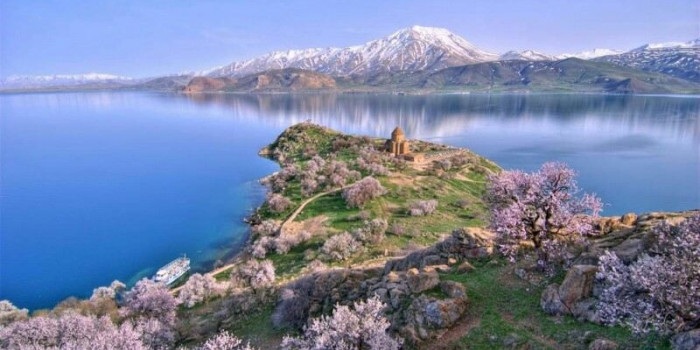
Озеро Севан — одно из самых красивых озер в мире, расположенное на высоте 2 000 метров над уровнем моря! Его называют жемчужиной Армении. И это неудивительно, тут открываются прекрасные природные виды, а вода чистейшая, имеющая лазурно-синий цвет!
Содержание
- Отношение армянских правителей к этому месту
- С чем связано название озера?
- Легенда возникновения озера
Отношение армянских правителей к этому месту
Население возле данного озера появилось задолго до того, как на эту территорию прибыли кочевые тюркские племена, которые пришли сюда еще в далеком 12 веке. В то время они следовали по Великому Шелковому пути, часть которого и пролегает у вод Севана.
Есть много доказательств того, что армянские народы обосновались тут еще в дохристианскую пору. Например, в селе Лчашен находится камень, на который нанесена надпись на языке Урарту. Текст свидетельствует о том, что в эти земли приезжал царь Аргишти Первый, который построил тут крепость с целью защитить границы собственного государства с восточной стороны.
Ученые изучили крепость, определив, что возведена она была в 8 веке до нашей эры. Впоследствии крепость уже применялась другим правителем Ашотом Вторым, когда он сражался с арабами.
С чем связано название озера?
Однако само название озера пошло с начала правления династии Арташесидов, которые руководили Великой Арменией. В то время, а именно во 2 веке до нашей эры, царь Арташес Первый возвел тут город. Как раз в эту пору к озеру переселились люди и стали обживаться здесь.
Ранее они жили возле озера под названием Ван. Прибыв к озеру Севан, они заметили, что оно очень похоже на их родное озеро Ван. И остров, и природа, все сильно напоминало прежнее место жительства. Поэтому изначально они стали называть озеро Ваном.
Но в дальнейшем, когда наступила зима, они увидели разницу. Зимняя пора тут очень суровая, мороз достигал -30 градусов. Жители в полной мере ощутили всю жестокость новой родины, поэтому переименовали озеро в Севан. Сев с армянского языка переводится как черный.
Легенда возникновения озера
Легенда гласит, что на территории озера ранее располагалась деревня с красивейшими садами, просторными лугами, плодородными землями. Возле поселка был ключ, который бил настолько сильно, что местные жители перекрывали отверстие.
Но один раз туда отправилась девушка, чтобы набрать воды, а закупорить отверстие забыла! Из ключа хлынула вода, стремительно залив всю окрестность. Когда жители спасались от наводнения, они проклинали того, кто забыл закрыть ключ, пожелали, что он превратился в камень.
Девушка тотчас окаменела.
А вода заливала село все больше и больше. В итоге образовалось озеро. На его территории есть полуостров, который по легенде, считается головой той самой забывчивой девицы.
Туристам, решившим попутешествовать по Армении, стоит посетить озеро Севан. Это по-настоящему красивейшее место!
ContDict.ru > Русско армянский словарь и переводчик
Вход
Регистрация
й
ё
ъ
ь
‘
—
Русская клавиатура
Русско-армянский словарь
Перевод «Севан» на армянский язык: «Սևան»
|
|
|
|
севан:
|
Սևան |
|
озеро Севан |
լիճն источник пожаловаться Langcrowd.com |
|
Озеро Севан покрыто арчевсом |
Սևանա լիճը փրված է արչևս источник пожаловаться Langcrowd.com |
Пожалуйста, исправьте перевод и/или сообщите о нарушениях, ошибках, грубой лексике:
|
Плохой пример Ошибки в тексте Грубая лексика Другое |
| Комментарий: |
|
Докажите, что вы не робот:
Зарегистрированные пользователи могут исправлять переводы! Зарегистрируйтесь или войдите на сайт для этого. |
Пожалуйста, помогите другим пользователям с корректировкой их текстов:
Йон — шерсть, перевод с татарского;
Юн — стругай ( если вариант твёрдого произношения);
Юн —
Русский
Пушаймон по руски
Русский
լիցքավորող սարքը нструирован եւ կառուցվել է բերել անվտանգությունը, արդյունավետությունը և
Армянский
Татэ
Армянский
Пожалуйста, помогите c переводом:
от куда ты че знаешь?
Русский-Армянский
Ես քեզ սիրում եմ
Русский-Армянский
Категории
Русский-Армянский
Увас как
Русский-Армянский
Пожалуйста, войдите или зарегистрируйтесь!
Популярные направления онлайн-перевода:
Английский-Русский Армянский-Русский Латынь-Русский Немецкий-Русский Сербский-Русский Татарский-Русский Турецкий-Русский Узбекский-Русский Хорватский-Русский Чешский-Русский
© 2023 ContDict.ru — контекстный словарь и переводчик
Privacy policy
Terms of use
Contact
ResponsiveVoice-NonCommercial licensed under (CC BY-NC-ND 4.0)




